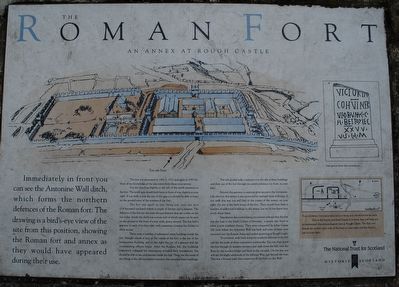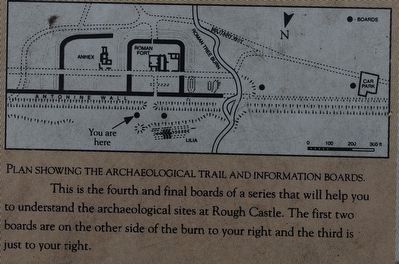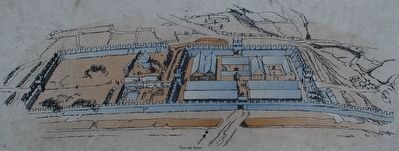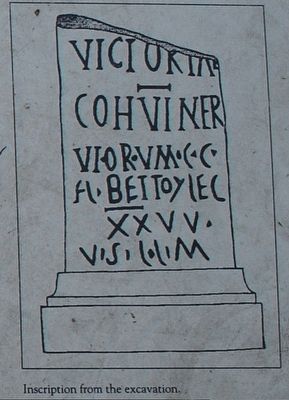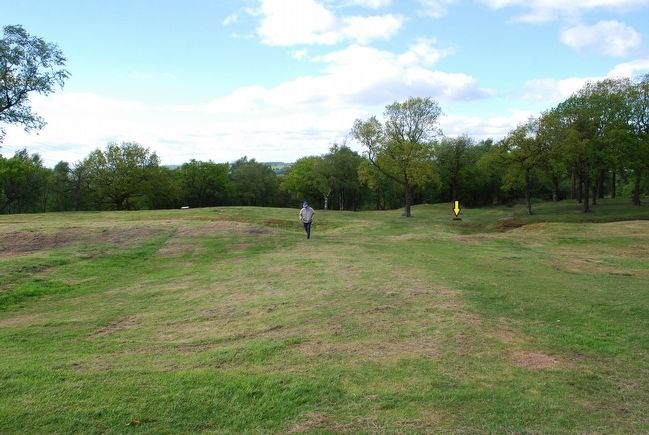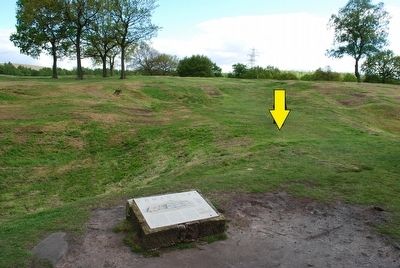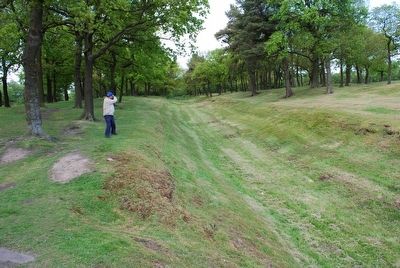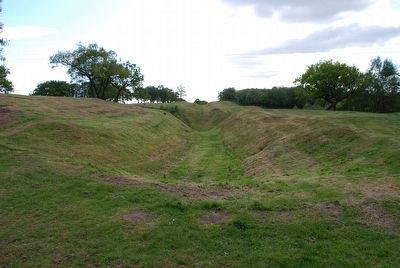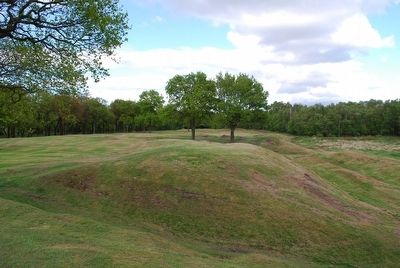Falkirk, Scotland, United Kingdom — Northwestern Europe (the British Isles)
The Roman Fort
An Annex at Rough Castle
— #4 —
Immediately in front you can see the Antonine Wall ditch, which forms the northern defences of the Roman fort. The drawing is a bird's-eye view of the site from this position, showing the Roman fort and annex as they would have appeared during their use.
The fort was excavated in 1902-3, 1932 and again in 1957-61. Most of our knowledge of the site comes from these excavations.
You are standing slightly to the left of the north entrance to the fort. The north gate would have been in front of you, slightly to your right. If you walk across the site of the gate you should be able to trace on the ground some of the remains of the fort.
The fort was small in size, being just over one acre (0.4 hectares) enclosed within a couple of ditches and a rampart. The defences of the fort are the most obvious features that are visible on the site today. Inside the ditch was a stout wall of which traces can be seen on the ground in the form of a low, wide, grassy mound. The fort had a gateway in each of its four sides, with causeways crossing the ditches to allow access.
There were a number of substantial stone buildings inside the fort. Straight ahead of you, in the centre of the fort, is the site of the headquarters building, and to the right the site of a granary and the commanding officers house. After the Romans left, the buildings completely collapsed but excavations revealed their foundations. You should be able to see undulations inside the fort. These are the result of the filling of the old excavation trenches that revealed these buildings.
The self-guided walk continues over the site of these buildings and then out of the fort through its eastern entrance (in front, to you left).
Beyond the gateway a causeway gives access to the fort annex. Like the fort, the annex is also protected by multiple lines of ditches. If you walk this way you will find in the corner of the annex, on your right, the site of the bath-house of the fort. There would have been a number of additional buildings in the annex, but we do not know very much about them.
Inscriptions discovered during excavation indicate that this fort was the base of the Sixth Cohort of Nervians, a people who lived in what is now northern France. They were conquered by Julius Caesar 200 years before the Antonine Wall was built and some of them were recruited into the Roman Army and ended up serving at Rough Castle.
To continue, walk back along the southern defences of the fort and see the scale of these impressive earthworks. You can then leave the fort through its western entrance and walk down the hill, over the Burn by the wooden bridge and back to the car park. On the way you will see the slight earthwork of the Military Way, just beyond the burn. This was a Roman road that connected all the forts on the Wall.
PLAN SHOWING THE ARCHAEOLOGICAL TRAIL AND INFORMATION BOARDS.
This is the fourth and final boards of a series that will help you to understand the archaeological sites at Rough Castle. The first two boards are on the other side of the burn to your right and the third is just to your right.
(Illustration Text)
Inscription from the excavation.
Topics. This historical marker is listed in these topic lists: Forts and Castles • Settlements & Settlers. A significant historical year for this entry is 1932.
Location. 55° 59.896′ N, 3° 51.369′ W. Marker is in Falkirk, Scotland. Touch for map. Marker is in this post office area: Falkirk, Scotland FK4 2EP, United Kingdom. Touch for directions.
Other nearby markers. At least 8 other markers are within 5 kilometers of this marker, measured as the crow flies. The Northern Defences (within shouting distance of this marker); The Antonine Wall (about 150 meters away, measured in a direct line); a different marker also named Antonine Wall (about 180 meters away); a different marker also named The Antonine Wall (approx. 0.3 kilometers away); Antonine Wall Rough Castle (approx. 0.8 kilometers away); Forth & Clyde Ship Canal (approx. one kilometer away); Battle of Falkirk Muir (approx. 2.6 kilometers away); The Parish Church Graveyard (approx. 4.4 kilometers away). Touch for a list and map of all markers in Falkirk.
Credits. This page was last revised on January 27, 2022. It was originally submitted on August 5, 2015, by Brandon Fletcher of Chattanooga, Tennessee. This page has been viewed 300 times since then and 6 times this year. Photos: 1, 2, 3, 4, 5, 6, 7, 8, 9. submitted on August 5, 2015, by Brandon Fletcher of Chattanooga, Tennessee. • Andrew Ruppenstein was the editor who published this page.
